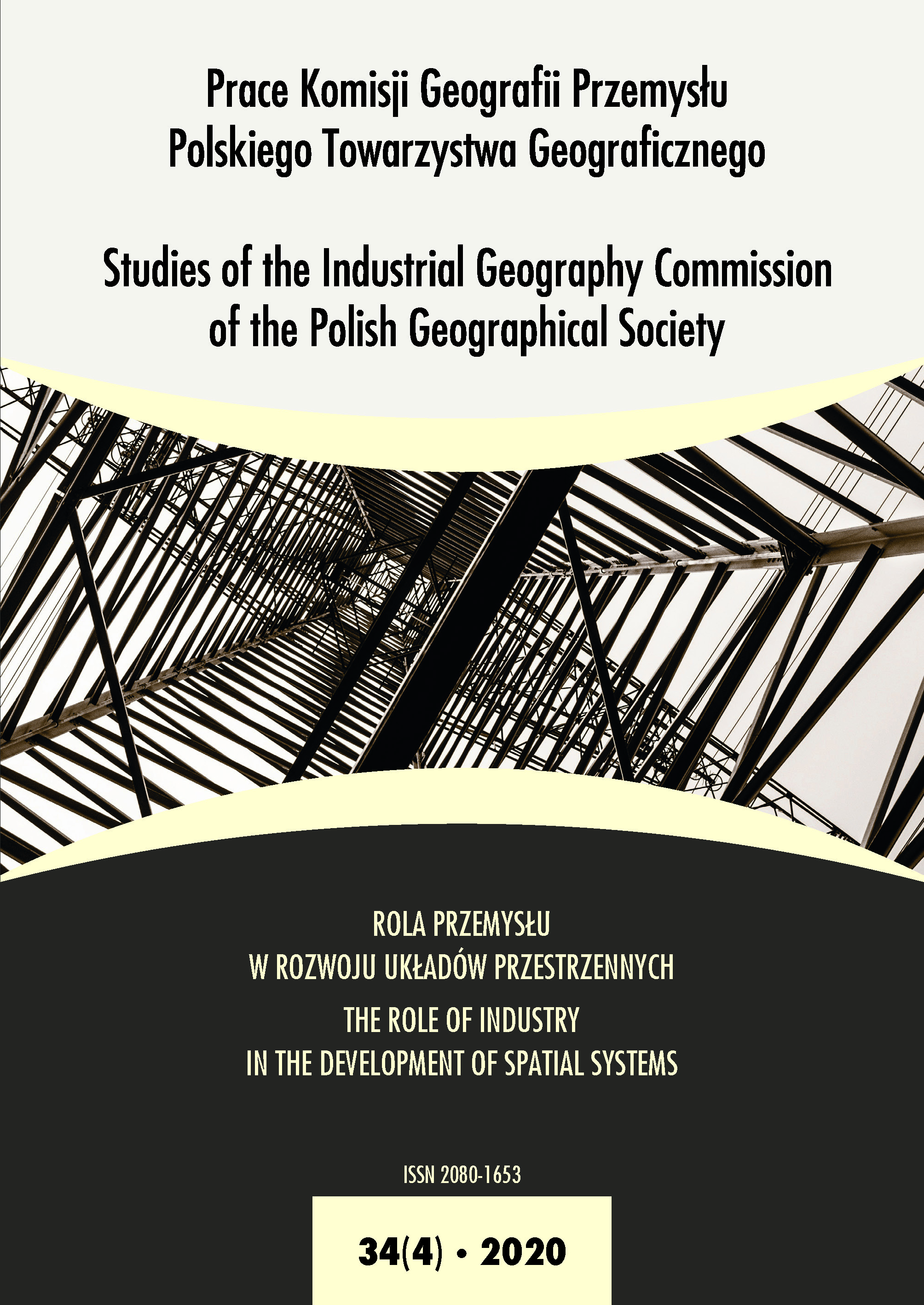Innovativeness of the Polish industry in the context of changes in the spatial differentiation of innovativeness in new EU member states
DOI:
https://doi.org/10.24917/20801653.344.6Keywords:
change in spatial patterns, industry, innovativeness, new EU member states, Poland, spatial differentiationAbstract
The paper addresses the issue of spatial differentiation in the level of industrial innovativeness in new EU member states from 2008 to 2017, with a particular focus on Poland. The purpose of the study is to attempt to describe changes in the spatial patterns of innovativeness in new EU member states (so-called EU13) and to indicate the position of Poland against the EU13 by using simple vector calculus. The period of analysis resulted from the availability of data. The paper presents matters related to the innovative activities of industrial enterprises and research and development (R&D) in Poland and other new EU member states. Selected features of innovativeness are shown as a relationship between expenditure and effect. The research confirms that the spatial pattern of industrial innovativeness in the EU13 significantly varies spatially between states. It is noteworthy that in the analysed period, the level of innovativeness in the Polish economy was relatively low compared to all EU countries as well as among the EU13. Moreover, the high growth figures obtained by Poland in most of the analysed features related to industrial innovativeness deserve to be emphasised. In 2008-2017 spatial differences in expenditure on R&D in the sector of industrial enterprises as well as their effects were highly stable.
Downloads
Metrics
References
Brezdeń, P. (2016). Wybrane aspekty wpływu kapitału zagranicznego na gospodarkę Dolnego Śląska – ujęcie przestrzenne [Selected Aspects of the Influence of Foreign Capital on the Lower Silesia Economy – a Spatial Perspective]. Prace Komisji Geografii Przemysłu Polskiego Towarzystwa Geograficznego [Studies of the Industrial Geography Commission of the Polish Geographical Society], 30(2), 72–94.
Brezdeń, P. (2018). Research Topics and Changes in the Spatial Structure of Innovativeness of Polish Industry in 2005–2015. Prace Komisji Geografii Przemysłu Polskiego Towarzystwa Geograficznego [Studies of the Industrial Geography Commission of the Polish Geographical Society], 32(4), 205–226.
Eurostat. (2019, October 14) Retrieved from: https://ec.europa.eu/eurostat/data/database.
European Innovation Scoreboard 2017. (2017). Retrieved from: https://www.rvo.nl/sites/default/files/2017/06/European_Innovation_Scoreboard_2017.pdf (Accessed on: 2019, November 12)
Furman, J. L., Porter, M. E., Stern, S. (2002). The determinants of national capacity. Research Policy, 31(6), 899–933.
Gajda, W. (2015). Innowacyjność polskiego przemysłu na tle przemysłu światowego. Prace Komisji Geografii Przemysłu Polskiego Towarzystwa Geograficznego [Studies of the Industrial Geography Commission of the Polish Geographical Society], 29(1), 42–55.
Guan, J., Chen, Z. (2009). The technological system of Chinese manufacturing industry. A sectorial approach. China Economic Review, 20(4), 767–776.
Klamut, M. (1996). Ewolucja struktury gospodarczej w krajach wysoko rozwiniętych. Wrocław: Wydawnictwo Akademii Ekonomicznej im. Oskara Langego.
Nauka i technika w 2015 r. Science and technology in Poland in 2015. (2016). Informacje i Opracowania Statystyczne. Warszawa: GUS; Urząd Statystyczny w Szczecinie.
Nowak, P. (2012). Poziom innowacyjności polskiej gospodarki na tle krajów UE. Prace Komisji Geografii Przemysłu Polskiego Towarzystwa Geograficznego [Studies of the Industrial Geography Commission of the Polish Geographical Society], 19, 153–168.
Parysek, J. (1976). Zmiany struktury przestrzennej przemysłu Polski w latach 1960–1973. Próba miernika syntetycznego. Przegląd Geograficzny, 48(2), 253–268.
Podręcznik Oslo. Pomiar działalności naukowej i technicznej. Zasady gromadzenia i interpretacji danych dotyczących innowacji. (2008). Warszawa: Ministerstwo Nauki i Szkolnictwa Wyższego, Departament Strategii i Rozwoju Nauki.
Rachwał, T., Wiedermann, K., Kilar, W. (2009). Rola przemysłu w gospodarce układów regionalnych Unii Europejskiej. Prace Komisji Geografii Przemysłu Polskiego Towarzystwa Geograficznego [Studies of the Industrial Geography Commission of the Polish Geographical Society], 14, 31–42.
Ulku, H. (2007). R&D, innovation, and growth. Evidence from four manufacturing sectors in OECD countries. Oxford Economic Papers 59(3), 513–535.
Weresa, M. (2018). Działalność badawczo-rozwojowa i innowacyjna a konkurencyjność polskiej gospodarki. In: Rola miast w kształtowaniu przewag konkurencyjnych Polski. Warszawa: Oficyna Wydawnicza SGH – Szkoła Główna Handlowa, 149–170 (Polska. Raport o konkurencyjności, 2018). Retrieved from: https://www.researchgate.net/publication/326370024_Dzialalnosc_BR_i_innowacyjna_a_konkurencyjnosc_polskiej_gospodarki (Accessed on: 2019, October 13)
Winiarski, B. (2002). Polityka gospodarcza (2nd ed.). Warszawa: Wydawnictwo Naukowe PWN.
Downloads
Published
How to Cite
Issue
Section
License
Articles are published under the terms of the Creative Commons License (CC BY-ND 4.0; Attribution– NoDerivs).

